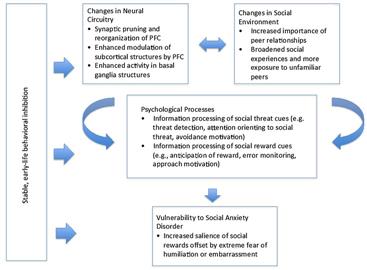Gaining insight into adolescent vulnerability for social anxiety from developmental cognitive neuroscience |
| |
| Affiliation: | Department of Human Ecology, Center for Mind and Brain, University of California, Davis, CA, United States |
| |
| Abstract: | 
Social anxiety disorder (SAD) markedly impairs daily functioning. For adolescents, SAD can constrain typical development precisely when social experiences broaden, peers’ opinions are highly salient, and social approval is actively sought. Individuals with extreme, impairing social anxiety fear evaluation from others, avoid social interactions, and interpret ambiguous social cues as threatening. Yet some degree of social anxiety can be normative and non-impairing. Furthermore, a temperament of behavioral inhibition increases risk for SAD for some, but not all adolescents with this temperament. One fruitful approach taken to understand the mechanisms of social anxiety has been to use neuroimaging to link affect and cognition with neural networks implicated in the neurodevelopmental social reorientation of adolescence. Although initial neuroimaging studies of adolescent SAD and risk for SAD underscored the role of fear-processing circuits (e.g., the amygdala and ventral prefrontal cortex), recent work has expanded these circuits to include reward-processing structures in the basal ganglia. A growing focus on reward-related neural circuitry holds promise for innovative translational research needed to differentiate impairing from normative social anxiety and for novel ways to treat adolescent SAD that focus on both social avoidance and social approach. |
| |
| Keywords: | Social anxiety Behavioral inhibition Reward Threat Striatum Amygdala |
| 本文献已被 ScienceDirect 等数据库收录! |
|

